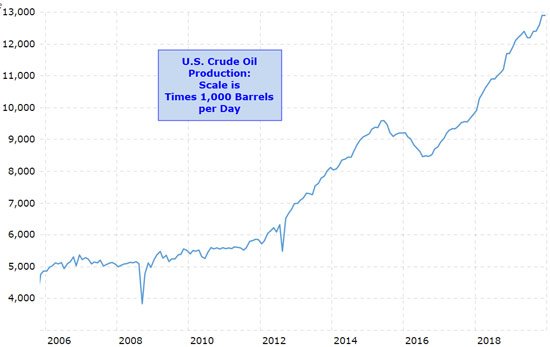The reality gap I'd like to explore today is one which the U.S. oil market already had the setup to be a huge moneymaker. And then it got better.
The U.S. airstrike which killed top Iranian general, Qassim Soleimani, sent oil prices spiking higher in the Thursday to Friday overnight market, greatly improving our entry for this reality gap trade. I'll explain this profit-making opportunity in more detail, but here's a quick take on this morning's market-moving news and what we can expect.
The financial markets are experiencing significant turmoil after the airstrike that I mentioned above. Defensive investments, or places where money flows in a flight to safety, have jumped higher. These include the Japanese yen, the Swiss franc, gold, and U.S. and German bonds.
That's a typical response when uncertainty hits the market - and a military strike like this definitely qualifies. But by the time I started writing this update to the column at 7:00 a.m. EST on Friday morning, the market reaction was already changing.
The market's fear gauge - the CBOE Volatility Index (VIX) - which had spiked higher on the news, was already falling, as were oil prices. And the major market indexes like the S&P 500 had already found their lows of the morning.
In short, the market's reaction to the airstrike is acting as a test of how much geopolitical risk matters in the markets right now. Said another way, there's a very good chance that the market just absorbs this news as a temporary blip. And that will be very good news for today's trade in a struggling U.S. shale oil producer...
The U.S. shale oil industry has revolutionized the crude oil market. And it was a major - if somewhat behind-the-scenes - driver of the recovery in the U.S. economy since 2009. Take a look at this production chart:

The impact of this shale oil boom on global oil economics has been immense.
But like the retail resurgence of 2019, the story of U.S. shale oil emergence is littered with haves and have nots. And as we'll see, right now it's easier to make money on one of the players that has struggled - and will continue to do so.
There's a reality gap in the shale oil world. The widely held belief is that the rising tide of crude oil production that we see in the chart above is lifting all ships. The reality is that some companies could be in big trouble because of the way they have raised money to finance their wells. And we can make money with that information that almost no one is telling you about it.
Some in the financial news media are even saying that U.S. oil companies are the best stocks to buy for 2020.
That prognostication is just people talking their book (touting the stocks they own in an effort to drive up the price), and it's dangerous to your wealth.
Now, I'm not saying that the shale industry is going under. Far from it. The "haves" will thrive, much as they did in the retail industry.
The reality gap is happening between what you're being told about U.S. fracking, and what's really happening on the ground...
More and more, small companies are about to go under. And you can make money while they do.
Shale Oil Made the U.S. a World Leader
Fracking, the technological revolution that allowed the U.S. to drill for oil and gas from previously inaccessible regions, has been a huge boon to America. In 2018, it made the United States the world's largest oil producer for the first time in almost 20 years.
That has taken the United States from the being dependent on the Middle East for much of our oil (many of us surely remember the oil embargos of past years) to being a net exporter of oil products.
Closer to home, the shale boom was also a key economic driver that pulled the U.S. economy out of the post-financial crisis doldrums.
| Back Then, No One Believed It (They're Kicking Themselves Now)
A single $1.5K stake in this sector back in 2010 would've landed you at No. 76 on Forbes' list of 100 Richest Americans. And simply by moving on America's most elusive industry now, you could see even a meager stake launch you straight to billionaire status. Go here to find out how. |
This shale revolution was spearheaded by small companies that experimented and developed "fracking" and other new techniques, in areas the big oil companies had abandoned.
To operate, these tiny companies relied on loans and speculative investments from Wall Street.
This financing has fueled the U.S. boom we saw in the chart above. As you'll recall, starting around 2009, American oil production shot through the roof. That's mostly thanks to shale oil.
Today, two-thirds of U.S. oil production comes from shale.
But this was a new technology at the time. So the funds and banks financing all this drilling had no good way of knowing how much a given well would produce.
No one had ever done anything like this before.
That's where the trouble started...
Fracking Is More Expensive than Anyone Thought
[mmpazkzone name="in-story" network="9794" site="307044" id="137008" type="4"]
Shale wells, like conventional wells, produce less and less oil and gas as time goes on. That was always expected.
But how quickly that slower production would come into play, no one knew since the technology was so new. So financiers accepted the shale companies' estimates for how quickly production would start to taper off.
Based on these estimates, shale oil companies borrowed billions to finance more wells and more production.
But now, according to analysis by Rystad Energy and The Wall Street Journal, it looks like these estimates were much too optimistic.
According to this little-reported study, shale oil and gas wells from the 29 largest producers in America are on track to produce a whopping 15% less oil and gas than the companies had originally estimated.
That's about 1.4 billion barrels less than estimated over 30 years, or about $60 billion at current oil and gas prices.
And that's the average. Some companies are looking at a production shortfall of more than 20%.
This gap between what we've been told about the oil industry and what's actually happening on the ground is huge.
Now, this shortfall will be made up for with new wells. The U.S. oil industry's production is going to continue to climb.
But this will hit smaller, less cash-rich oil companies hard. These are often the same companies that pioneered shale fracking and did so using loans. With their production not hitting estimated targets, cash flow to pay the interest on the debt drops, and they're in trouble.
That's why I believe buying some longer term puts or shorting the stocks of the shale oil "have nots" is one of the best plays in the market right now. And today's pop up in oil prices due to geopolitical unrest is just what the doctor ordered for an even more favorable entry.
Whiting Petroleum Corp. (NYSE: WLL) has been one of the "have nots" for the last year and a half. As industry expert and good friend of mine Matt Warder told me this week - the company is in the wrong region (less productive shale basin) and on the wrong side of the decline curve. They're cutting maintenance capital expenditures (trading short-term gain for long-term pain), and they have a horrible debt position.
This morning's pop gives a good chance to short this stock or buy out-of-the-money puts three to six months out, depending on how aggressive you'd like to be.
When this reality comes home to roost, the overly aggressive borrowing by this shale oil "have not" could add nicely to your bottom line.
The post Turmoil in Middle East Makes this Reality Gap Trade in Oil Even Better appeared first on 10 Minute Millionaire.
About the Author
D.R. Barton, Jr., Technical Trading Specialist for Money Map Press, is a world-renowned authority on technical trading with 25 years of experience. He spent the first part of his career as a chemical engineer with DuPont. During this time, he researched and developed the trading secrets that led to his first successful research service. Thanks to the wealth he was able to create for himself and his followers, D.R. retired early to pursue his passion for investing and showing fellow investors how to build toward financial freedom.



